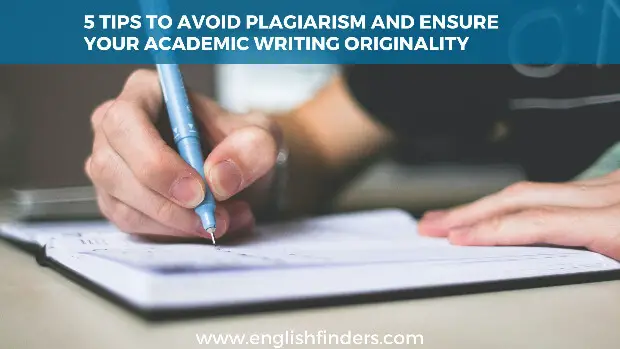In this article, we’re going to provide you with five advanced tips to avoid plagiarism so that you can ensure your academic writing originality. What is plagiarism? It is stealing someone’s work (either intentionally or unintentionally) and using it in your work without crediting the original author.
There are many types of plagiarism, such as:
- Source-based plagiarism
- Direct plagiarism
- Self-plagiarism
- Mosaic plagiarism
- Accidental Plagiarism
…and so on.
Committing plagiarism has serious consequences, and its repercussions include:
- Ruined reputation
- Inability to find a career in the same field again
- Monetary loss
- Legal repercussions
In 2022, it will be effortless to detect plagiarism using technology. Digital documents can be scanned by specialized plagiarism-checking software, and it (the software) can detect if that document has plagiarism in it or not. Due to this, nobody actually intentionally plagiarizes anymore because they know they cannot get away with it.
However, the problem starts when we put accidental plagiarism in the picture. Unintentional plagiarism can occur due to a myriad of reasons, but the most common ones are:
- Incorrect citation
- Incorrect quotation
- Incorrect paraphrasing
In this article, we will discuss how you can avoid plagiarism in your academic writing.
5 Tips to Avoid Plagiarism in Academic Writing
Quick Navigation

1. Keep Track of Your Sources
When writing a research paper, you must build upon other people’s work. In other words, you read a lmanyoks and research papers and use the facts and ideas provided to create something reliable and authoritative.
However, as time goes on and you delve deeper into your own research, you can forget where you got certain ideas from.
At this point, most people mistakenly assume that certainly borrowed ideas were their own and they forget to cite them.
This is considered plagiarism. Using the ideas of another without crediting them is wrong.
This can be avoided if you keep a list of all your sources. A source is any paper o, book, or website log you have used in your work.
Hence, keeping a list in either digital or physical form will help you keep track of what ideas originated from which source.
You can use specialized tools that help you keep track of sources or you can make an Excel sheet.
2. Cite Correctly
Incorrect citation is another factor that increases the amount of accidental plagiarism in one’s work. The plagiarism resulting from an incorrect citation is referred to as ‘source-based’ plagiarism.
In academic writing, you must provide a valid source whenever you have to configure a fact about a phenomenon. This action is called ‘citing a source’ or ‘citation.’
Citations are given in brackets at the end of any information or idea presented in the work (taken from somewhere else). Every in-text citation has a corresponding detailed reference given at the end of the document, which further describes the details of the source.
When writing a paper, the format is predetermined by the institute you study in or are collaborating with. If multiple different formats are used in one paper, then that is a case of incorrect citation.
If the author’s name, publication title, journal title, or date is wrong, then that is also considered an incorrect citation. And as we mentioned above, all counts of incorrect citations are considered plagiarism.
So, to avoid plagiarism, cite your sources correctly.
3. Paraphrase Where Necessary

Not all facts and ideas need to be cited. So a lot knows people’s opinions or bits of knowledge which is not attributed to anyone in particular. Such data can be used in your work without any citations.
However, even then, the words with which you share that knowledge may be the same as (or mostly similar) to someone else’s.
This is also considered plagiarism since you are using someone’s words verbatim. In this case, you can paraphrase the duplicated part. The paraphrase tool can automatically rephrase and reword the text you provide without changing its meaning.
4. Reference Section/Bibliography

A bibliography is a list of all the sources that have been cited in the work. This list has usually presented at the end of a paper/book and allows a format.
The most common formats are APA, AMA, MLA, and Chicago. They differ in what parts of the source they show first and how their in-text citations look.
If you add an in-text citation but don’t have any reference list, that will confuse your readers. They won’t have any way of knowing which sources you cited because there is no reference list to guide them. This also falls under plagiarism, as you are not listing the sources.
Another thing to ensure is that you must stick with one format of citing and referencing. If the styles mismatch or you use multiple styles in one piece, then that will cause problems. So, be consistent with formats.
5. Check for Plagiarism

Lastly, no matter how many precautions you take, human error will still come into play. This means that even after all your precautions, you may still have some plagiarism in your work.
What you can do to rectify that is to use a plagiarism checker. Plagiarism checkers are online tools that can scan digital documents and detect any plagiarism they might have.
These tools are considered reliable enough since universities employ them for plagiarism checking. You can use one such tool to check your own work.
If the tool does find anything, it will do three things.
- A percentage of plagiarism found will be given.
- The plagiarized parts will be highlighted.
- The links/URLs of the plagiarized sources will be given.
With this information in your hands, you can do three things.
You can cite the sources so that plagiarism is eliminated. You can also remove the part that was plagiarized.
Or you can use a paraphraser to rewrite that specific part, so it is not recognized as duplicated anymore.
Conclusion
You can follow five steps to avoid plagiarism in your work. Do note that these tips are not infallible. Some of them will work better than others. You can employ these tips to make sure that the maximum amount of plagiarism is avoided.





